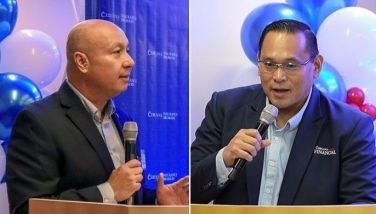Developing Dumaguete’s entrepreneurs
March 22, 2004 | 12:00am
Exemplary private-public partnership for the development of Filipino entrepreneurship is happening in Dumaguete City, Negros Oriental.
The provincial office of the Department of Trade and Industry and the local government, together with the Negros Oriental Business Development Foundation (representing the private sector) mounted the NOBDF Innovation Awards to discover and fund innovations in the areas of agriculture, health, environment, science, engineering, and information technology. Contenders formed teams and submitted business plans.
The finalists were publicly recognized and received cash prizes to start up their winning enterprises and gained access to a network of resources for team-building, mentoring, education, and capital on the condition that the enterprises are based in Negros Oriental.
The prime movers, comprised of LGU representatives, DTI provincial director Javier Fortunato, Jr., and NOBDF chairman Gregorio Uymatiao, Jr., conceptualized, managed, and funded the awards.
The 39 teams who participated in the awards included high school/collegiate/masteral/doctoral students, faculty of local institutions (Dumaguete being an educational center) as well as out-of-school youth groups. The process was managed in three stages:
• Submission of a three-page concept paper which provided data on the proponent, the project, and a response to a nine-point questionnaire;
• Evaluation by a multi-sectoral technical working group leading to a shortlist of 10 semi-finalists, who subsequently prepared for their respective business plans; and
• Coming up with five finalists who each publicly presented his/her plan to a board of judges.
The selection was based on the following criteria–the clarity of the business model, identification of the market potential, clear differentiation and competitive advantage, team composition and strengthen, financial soundness, and innovation.
The size of the start-up funds varied. All 10 semi-finalists received funds. The five who did not make it to the finals were each given P1,000. The finalists divided a total of P100,000, which ranged from a low of P5,000 to a high of P50,000.
• Automated watering system
A group of four senior computer engineering students of Asian College of Science and Technology entered their automated farm watering system controller. The students designed and produced a nine-volt prototype that had sensors on water level, rain, and soil humidity. The prototype activated valves that allowed water to flow to an area where the sensors detected a lack of water. The device could also be programmed to dispense water on a timed basis. The device brought down the cost of farm watering automation to less than P1,200.
• Wireless alarm for cell phones
A group of engineering students from the College of Engineering of Silliman University comprised Feel TeK, a branch of Vortex Venture Club which is a special program of the university to enhance the students’ skills in entrepreneurial engineering. Club members are supported via a club room that has research and development facilities that the students can use to conduct experiments and to work on prototypes.
The product of Feel TeK is an alarm that warns a cell phone owner if his/her phone is out of range. The product is composed of two devices. One is in the cell phone and the other can be attached to the owner. At a predetermined distance, the wireless device will signal the owner that the phone is no longer in range. Based on their business plan, the product will be positioned as a preventive device that will reduce owner stress and trauma brought about by the loss a cell phone.
• Cost effective ink jet and photo copying ink
Two high school students of Ramon Teves Pastor Dumaguete Regional Science High School came up with an ink called SCI, which is the acronym for soya oil, charcoal, and isopropyl alcohol. These high school students experimented and successfully produced a substitute for the ink used in ink jet and photo copying machines. They have tested their product and made a business plan to roll out their product.
Aside from the three major ingredients, the students also used gemelina fruit extract. The process requires a series of filtrations resulting in a print quality that is indistinguishable to commercially available ink. The product will bring down the cost of ink by 80%.
The product is being incubated in Dumaguete and, following the business plan, is now ready for commercialization.
• Bricks from waste materials
A faculty member of the Dumaguete City High School developed a construction/building material made of waste materials from acetylene and gas manufacturing. The material is calcium oxide or CalBricks.
Strength is what this product brings to the market. With a price lower than the products currently available in the market, this construction material offers better strength. The business plan is targeting the Dumaguete market first and will use its initial success as a springboard to conquer the rest of the province and then neighboring provinces. The product will be used in Dumaguete City High School to serve as testimony to the product’s performance.
• Live fish transported without water
A team of Silliman University graduates presented a business plan for a project called SALT, a solution that emulates the conditions of hibernation.
The discovery will change the rules of the live fish transport game. Under the current technology, a kilo of live fish is transported at a gross weight of four kilos, with salt water accounting for three kilos. In addition to the weight issue, live fish move during transport and their motion can puncture the plastic container and cause a leak, resulting in water loss and death to the fish.
Based on experiments, dipping the fish in a water bath containing the SALT solution ensures 100% survival of fish within a nine-hour period. The fish jumps to life as soon as it is put in water again. This innovation will bring down the air transport cost of live fish by 75%. The business plan speaks of franchising the use of the technology via manuals and the training of handlers in the proper use of the technology. The SALT solution itself will also be sold separately by franchisees.
The biggest discovery in this exercise is the power of innovation and development entrepreneurship using public-private sector partnership. It brings home the point that entrepreneurship is the best tool for poverty alleviation and economic development. It surfaces the simple truth that our vision for an entrepreneurial Philippines is a reality that can be ours sooner than later. It is never too late for more public-private partnership success stories beyond Dumaguete.
(Alejandrino J. Ferreria is the dean of the Asian Center for Entrepreneurship of the Asian Institute of Management. For further comments and inquiries, you may contact him at: [email protected]. Published "Entrepreneur’s Helpline" columns can be viewed on the AIM website at http//: www.aim.edu.ph).
The provincial office of the Department of Trade and Industry and the local government, together with the Negros Oriental Business Development Foundation (representing the private sector) mounted the NOBDF Innovation Awards to discover and fund innovations in the areas of agriculture, health, environment, science, engineering, and information technology. Contenders formed teams and submitted business plans.
The finalists were publicly recognized and received cash prizes to start up their winning enterprises and gained access to a network of resources for team-building, mentoring, education, and capital on the condition that the enterprises are based in Negros Oriental.
The prime movers, comprised of LGU representatives, DTI provincial director Javier Fortunato, Jr., and NOBDF chairman Gregorio Uymatiao, Jr., conceptualized, managed, and funded the awards.
The 39 teams who participated in the awards included high school/collegiate/masteral/doctoral students, faculty of local institutions (Dumaguete being an educational center) as well as out-of-school youth groups. The process was managed in three stages:
• Submission of a three-page concept paper which provided data on the proponent, the project, and a response to a nine-point questionnaire;
• Evaluation by a multi-sectoral technical working group leading to a shortlist of 10 semi-finalists, who subsequently prepared for their respective business plans; and
• Coming up with five finalists who each publicly presented his/her plan to a board of judges.
The selection was based on the following criteria–the clarity of the business model, identification of the market potential, clear differentiation and competitive advantage, team composition and strengthen, financial soundness, and innovation.
The size of the start-up funds varied. All 10 semi-finalists received funds. The five who did not make it to the finals were each given P1,000. The finalists divided a total of P100,000, which ranged from a low of P5,000 to a high of P50,000.
A group of four senior computer engineering students of Asian College of Science and Technology entered their automated farm watering system controller. The students designed and produced a nine-volt prototype that had sensors on water level, rain, and soil humidity. The prototype activated valves that allowed water to flow to an area where the sensors detected a lack of water. The device could also be programmed to dispense water on a timed basis. The device brought down the cost of farm watering automation to less than P1,200.
• Wireless alarm for cell phones
A group of engineering students from the College of Engineering of Silliman University comprised Feel TeK, a branch of Vortex Venture Club which is a special program of the university to enhance the students’ skills in entrepreneurial engineering. Club members are supported via a club room that has research and development facilities that the students can use to conduct experiments and to work on prototypes.
The product of Feel TeK is an alarm that warns a cell phone owner if his/her phone is out of range. The product is composed of two devices. One is in the cell phone and the other can be attached to the owner. At a predetermined distance, the wireless device will signal the owner that the phone is no longer in range. Based on their business plan, the product will be positioned as a preventive device that will reduce owner stress and trauma brought about by the loss a cell phone.
• Cost effective ink jet and photo copying ink
Two high school students of Ramon Teves Pastor Dumaguete Regional Science High School came up with an ink called SCI, which is the acronym for soya oil, charcoal, and isopropyl alcohol. These high school students experimented and successfully produced a substitute for the ink used in ink jet and photo copying machines. They have tested their product and made a business plan to roll out their product.
Aside from the three major ingredients, the students also used gemelina fruit extract. The process requires a series of filtrations resulting in a print quality that is indistinguishable to commercially available ink. The product will bring down the cost of ink by 80%.
The product is being incubated in Dumaguete and, following the business plan, is now ready for commercialization.
• Bricks from waste materials
A faculty member of the Dumaguete City High School developed a construction/building material made of waste materials from acetylene and gas manufacturing. The material is calcium oxide or CalBricks.
Strength is what this product brings to the market. With a price lower than the products currently available in the market, this construction material offers better strength. The business plan is targeting the Dumaguete market first and will use its initial success as a springboard to conquer the rest of the province and then neighboring provinces. The product will be used in Dumaguete City High School to serve as testimony to the product’s performance.
• Live fish transported without water
A team of Silliman University graduates presented a business plan for a project called SALT, a solution that emulates the conditions of hibernation.
The discovery will change the rules of the live fish transport game. Under the current technology, a kilo of live fish is transported at a gross weight of four kilos, with salt water accounting for three kilos. In addition to the weight issue, live fish move during transport and their motion can puncture the plastic container and cause a leak, resulting in water loss and death to the fish.
Based on experiments, dipping the fish in a water bath containing the SALT solution ensures 100% survival of fish within a nine-hour period. The fish jumps to life as soon as it is put in water again. This innovation will bring down the air transport cost of live fish by 75%. The business plan speaks of franchising the use of the technology via manuals and the training of handlers in the proper use of the technology. The SALT solution itself will also be sold separately by franchisees.
The biggest discovery in this exercise is the power of innovation and development entrepreneurship using public-private sector partnership. It brings home the point that entrepreneurship is the best tool for poverty alleviation and economic development. It surfaces the simple truth that our vision for an entrepreneurial Philippines is a reality that can be ours sooner than later. It is never too late for more public-private partnership success stories beyond Dumaguete.
(Alejandrino J. Ferreria is the dean of the Asian Center for Entrepreneurship of the Asian Institute of Management. For further comments and inquiries, you may contact him at: [email protected]. Published "Entrepreneur’s Helpline" columns can be viewed on the AIM website at http//: www.aim.edu.ph).
BrandSpace Articles
<
>
- Latest
Latest
Latest
November 28, 2024 - 8:00am
November 28, 2024 - 8:00am
November 25, 2024 - 1:00pm
November 25, 2024 - 1:00pm
November 19, 2024 - 12:00am
November 19, 2024 - 12:00am
November 18, 2024 - 9:32am
November 18, 2024 - 9:32am
October 16, 2024 - 4:00pm
By Aian Guanzon | October 16, 2024 - 4:00pm
October 1, 2024 - 9:00am
October 1, 2024 - 9:00am
Recommended






























